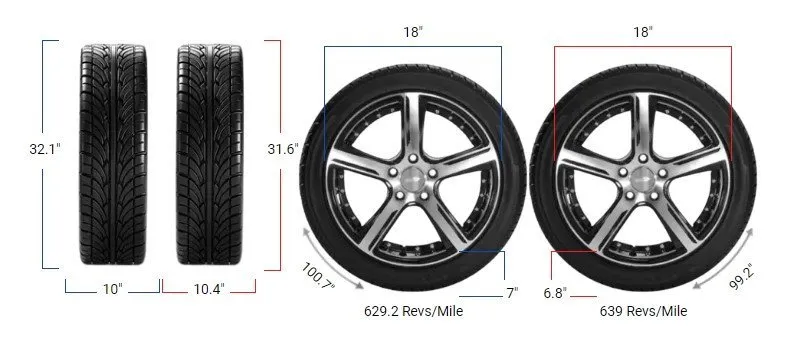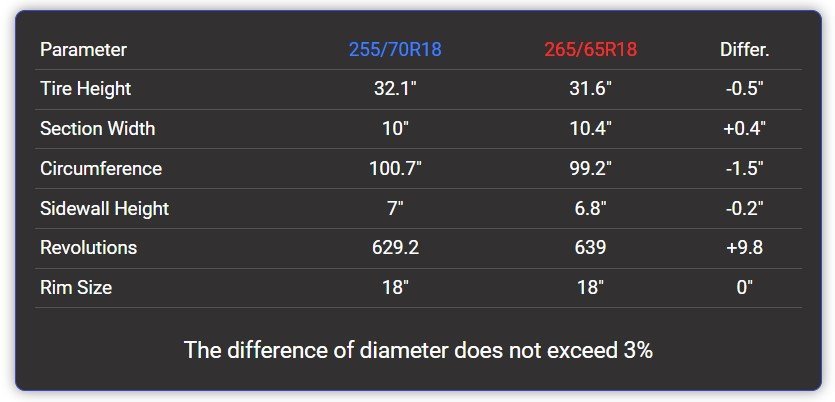Tire Size 255/70r18 vs 265/65r18

The switch from 255/70R18 to 265/65R18 tires is generally acceptable, with a diameter difference of only 1.5%. This change will result in slightly wider tires with a lower profile. While the difference is minimal, it may affect vehicle performance and appearance. Consider potential impacts on handling, fuel efficiency, and speedometer accuracy before making the switch.
- Diameter decrease of 1.5% falls within the recommended 3% range.
- New tires are 0.39 inches (10 mm) wider.
- Sidewall height decreases by 0.25 inches (6.25 mm).
- Slight impact on speedometer accuracy and fuel economy.
255/70r18 vs 265/65r18 Table

The primary difference when switching from 255/70R18 to 265/65R18 tires is the increased width and decreased sidewall height. The new tires are 0.39 inches (10 mm) wider, which can improve traction and stability. However, the sidewall height decreases by 0.25 inches (6.25 mm), potentially affecting ride comfort and off-road performance.
Fitment Guide
It’s crucial to stay within the recommended 3% diameter range. In this case, the diameter difference is -1.5%, falling well within the acceptable limits.
This means the 265/65R18 tires are suitable replacements for the 255/70R18 without requiring significant modifications to your vehicle.
On-Road Impact
The 265/65R18 tire size offers a balance between comfort and stability for on-road driving. Learn how this size affects fuel efficiency, handling, and ride quality on paved surfaces.
- Handling: The wider 265/65R18 tires may provide improved traction and stability on dry roads. The increased contact patch can enhance cornering performance and overall grip. However, the difference is relatively small, so the improvement might be subtle.
- Fuel Efficiency: The slight decrease in tire diameter may lead to a marginal decrease in fuel efficiency. The engine will need to work slightly harder to maintain the same speed, but the impact should be minimal – likely less than 1 mpg difference.
- Speedometer Accuracy: With the -1.5% change in diameter, your speedometer will read slightly higher than your actual speed. For example, when your speedometer shows 20 mph, you’ll actually be traveling at 19.69 mph. While this difference is small, it’s worth keeping in mind for precise speed control.
- Ride Comfort: The lower profile of the 265/65R18 tires might result in a slightly firmer ride. The reduced sidewall height means less cushioning between the road and your vehicle. However, the change is minimal, and most drivers may not notice a significant difference in comfort.
Off-Road Impact
Designed for versatility, the 265/65R18 tire size excels in off-road conditions. Find out how this tire size enhances traction, durability, and performance on challenging terrains.
- Ground Clearance: The switch to 265/65R18 tires will reduce your overall ground clearance by about 0.25 inches (6.25 mm). This small change is unlikely to have a noticeable impact on most off-road situations, but it’s worth considering if you frequently tackle challenging terrain.
- Traction: The wider 265/65R18 tires may provide better traction in some off-road conditions, particularly in mud or sand. The increased width can help distribute the vehicle’s weight more evenly, potentially reducing the risk of getting stuck.
- Durability: The lower profile of the 265/65R18 tires means there’s slightly less sidewall to absorb impacts from rocks and other off-road obstacles. This could potentially increase the risk of sidewall damage during extreme off-road use, but for most casual off-roading, the difference should be negligible.
Aesthetics Look
The switch to 265/65R18 tires will give your vehicle a slightly more aggressive look. The wider tires will fill out the wheel wells more, potentially enhancing the overall appearance of your vehicle.
However, the change is subtle, and many people may not notice the difference unless they’re specifically looking for it.
Durability and Wear
The difference in tire size is unlikely to have a significant impact on overall durability and wear.
However, the wider 265/65R18 tires may experience slightly more wear on the outer edges if not properly aligned. It’s essential to maintain proper tire pressure and alignment to ensure even wear and maximize tire life.
Our Observation
Switching from 255/70R18 to 265/65R18 tires offers a balanced mix of benefits and minor drawbacks. The wider tires provide slightly improved traction and stability, which can be beneficial both on and off-road. However, the lower profile may result in a marginally firmer ride.
The impact on fuel efficiency and speedometer accuracy is minimal and unlikely to cause significant issues for most drivers. Off-road performance may see a slight improvement in traction, but with a negligible decrease in ground clearance.
Overall, the differences are subtle enough that many drivers may not notice substantial changes in their day-to-day driving experience, making this a viable tire switch for those seeking a minor upgrade or replacement option.
- Will switching to 265/65R18 tires affect my vehicle’s warranty?
A: It’s unlikely to affect your warranty, but always check with your vehicle manufacturer or dealer to be sure. - Do I need to reprogram my speedometer after switching to 265/65R18 tires?
A: While not strictly necessary, you may want to consider reprogramming for precise accuracy. The difference is small enough that many drivers choose not to reprogram. - Will 265/65R18 tires fit on my current wheels?
A: They should fit, but always check your wheel specifications to ensure compatibility. - How will the switch affect my vehicle’s acceleration and braking?
A: The impact on acceleration and braking should be minimal due to the small difference in overall diameter. - Do I need to change all four tires at once?
A: It’s generally recommended to change all four tires to ensure balanced handling and performance. - 265/70r15 vs 235/75r15

Meet Caitlin McCormack, a Tire Size Expert and Blogger Passionate About Everything Related to Tires. With Years of Experience in the Tire Industry, Caitlin Has Become an Expert in Tire Sizes and Their Impact on Vehicle Performance.
